I was out of the county last week at 4H camp, so this update is for this week and last week which makes it a bit long. There is a lot of good information in here from specialists, as well as some meeting reminders at the end. I highly encourage cotton producers to attend the GA Cotton Commission Mid-Year Meeting, I will be taking the county truck to the event and have room for four more in my truck if anyone wants to save some gas money and ride along with me, just give me a call.
Topics Included in This Newsletter
- Investigation 93 Little Threat to Georgia (Pam Knox, UGA Climatologist)
- Row Crop Disease Update (Dr. Bob Kemerait, UGA Plant Pathologist)
- Florida Beggarweed in Peanut (Dr. Eric Prostko, UGA Weed Specialist)
- July Peanut Insect Update (Dr. Mark Abney, UGA Peanut Entomologist)
- Extension Precision Ag and Irrigation Blog Post (Dr. Wes Porter, UGA Precision Ag and Irrigation Specialist)
- July Cotton Team Newsletter and Talkin’ Cotton Podcast – UGA Cotton Team
- All About the Pod Podcast – UGA Peanut Team
- Trump Administration Announces Expedited Congressionally Mandated Disaster Assistance for Farmers
- Upcoming Meetings and Events
- 4-D Farm The Digital, Data-Driven Demonstration Farm
- GA Cotton Commission Mid-Year Meeting
Investigation 93 Little Threat to Georgia (Pam Knox, UGA Climatologist)

Some of you may have noticed a swirl of clouds off the Southeast Coast in the past few days. This was named as Investigation 93 yesterday as it began to show some tropical characteristics. Invest 93 is moving west over the Florida Peninsula over the next day and then will move over the NE Gulf before possibly organizing enough to become Tropical Storm Dexter. Depending on the exact path of the storm, Invest 93 may stay as an investigation or pull itself together enough to get named. In either case, it is expected to stay south of Georgia and eventually, west of Georgia as it turns to the north. The only impacts I am expecting from this messy mass of storms is some rain, especially in south and west Georgia. Even so, it probably won’t be more than an inch or so, which you have already been experiencing frequently this summer. If you are on a Gulf beach, there could be riptides. So don’t worry too much about this storm, if it does form. Just keep in mind that we are not yet in the main part of the tropical season and this is a sign that things may become more active in the next few weeks. If you haven’t got your planning done, now is a great time to do it!
Row Crop Disease Update (Dr. Bob Kemerait, UGA Plant Pathologist)
White Mold, Southern Stem Rot on Peanut
Early development of white mold (southern stem rot) on peanut. But given the rotation history in that field and our current hot day warm night high humidity scattered rainfall, this grower and others have a tough road ahead for the battle with this disease. For fields with short rotation we should consider increasing our rate of fungicide.
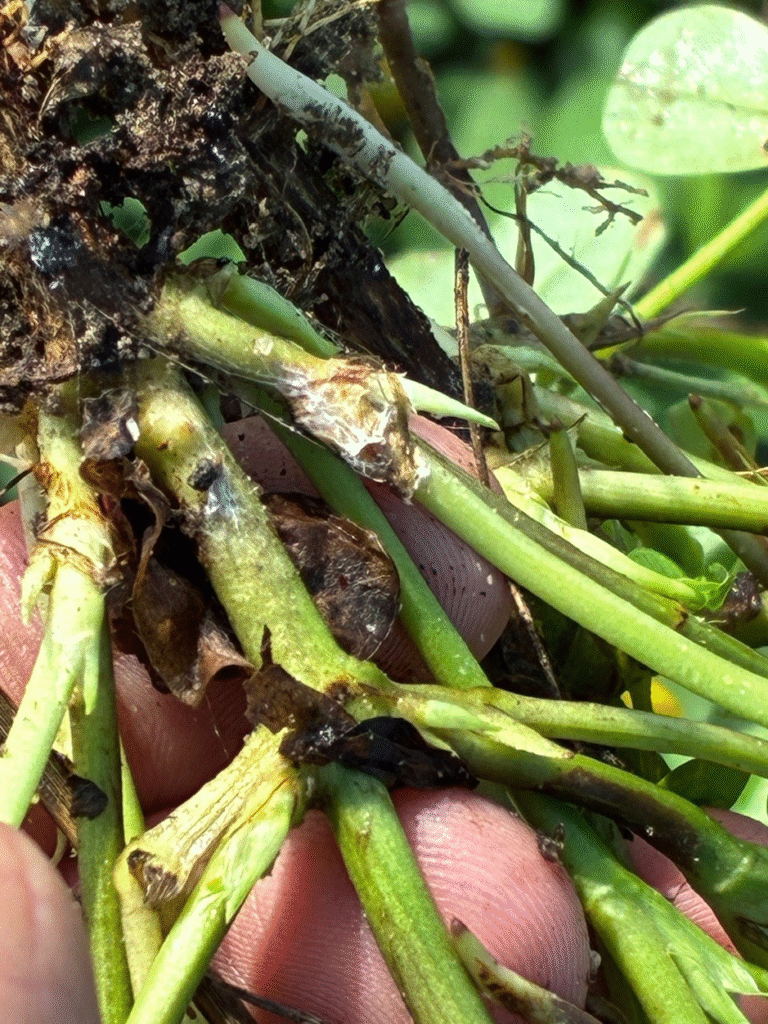
White Mold (Southern Blight) on Soybeans
While it is not uncommon, we see white mold on soybeans much less frequently than we see it on peanut. Finding white mold now on soybeans is clear indication that we need prepared with a good fungicide program for managing white mold and leaf spot
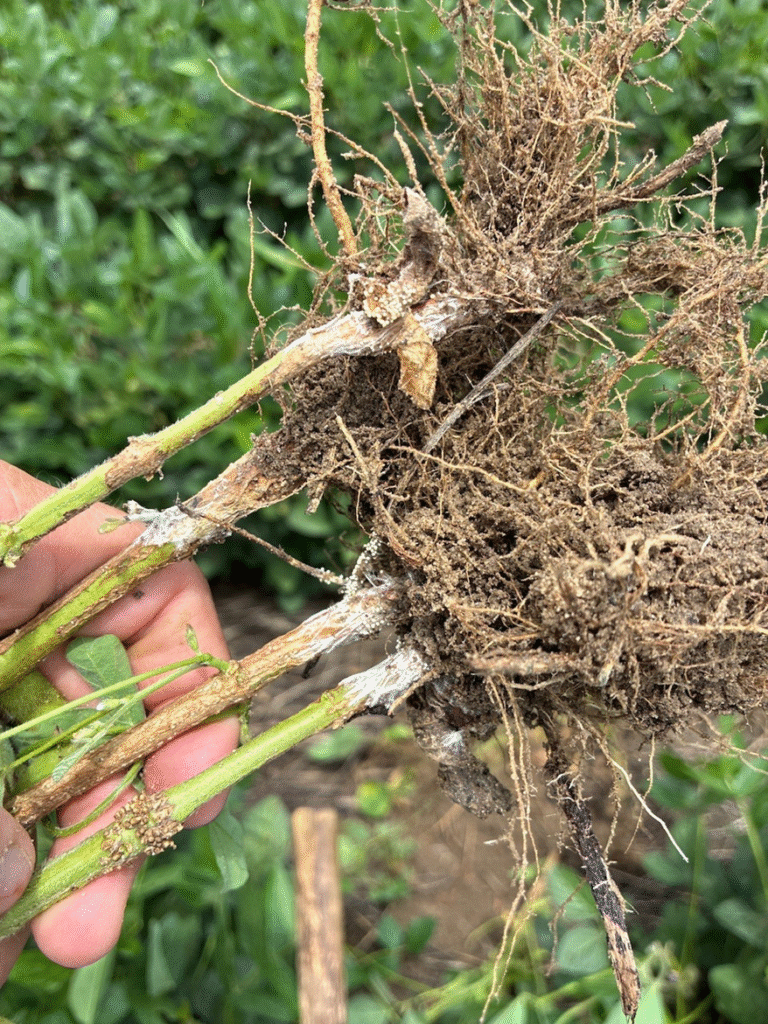
Gray Leaf Spot of Corn
Caused by Cercospora zeae-maydis, which prefers the cooler conditions of northern Georgia. Gray leaf spot lesions have a very characteristic “rectangle” shape that makes diagnosis fairly easy. To see this disease now in Burke and Jefferson Counties is likely the result of significant rainfall and overcast days earlier in the season. It can be a significant threat to corn.
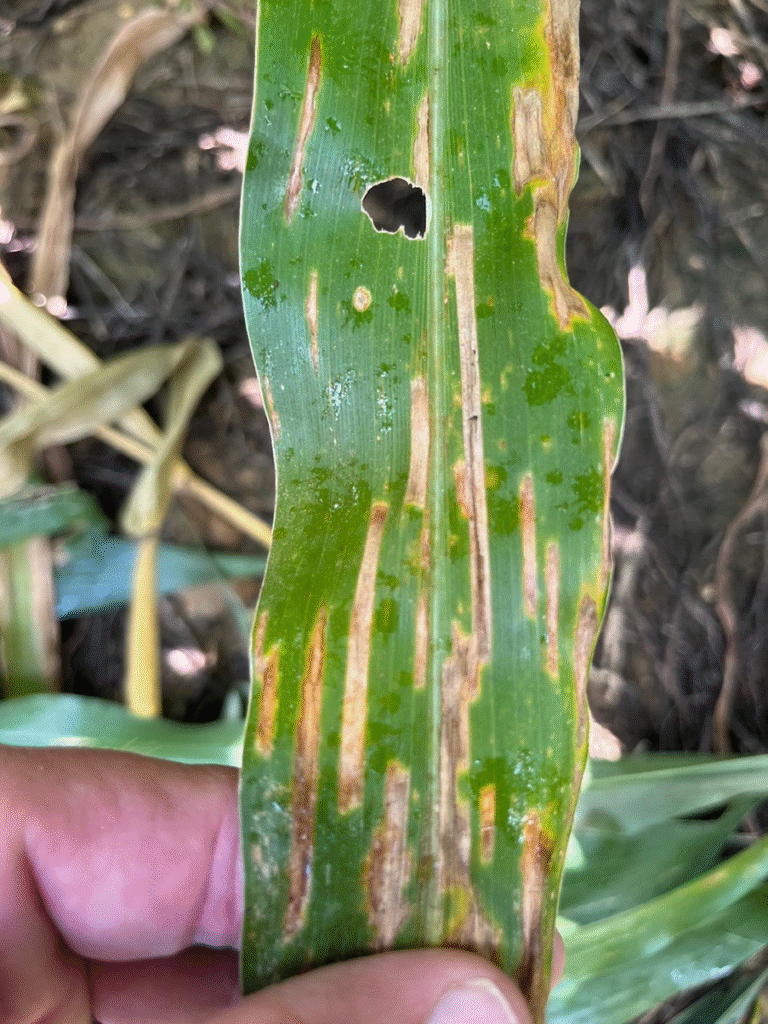
Foliar Symptom of Potential Nematode Damage on Cotton
This interveinal chlorosis, “tiger striping” is almost guaranteed to be the result of nematode damage to the cotton roots interfering with nutrient uptake; I am fairly confident that the culprit will be the southern root-knot nematode (Meloidogyne incognita) and that he should take a look at the roots for galing.
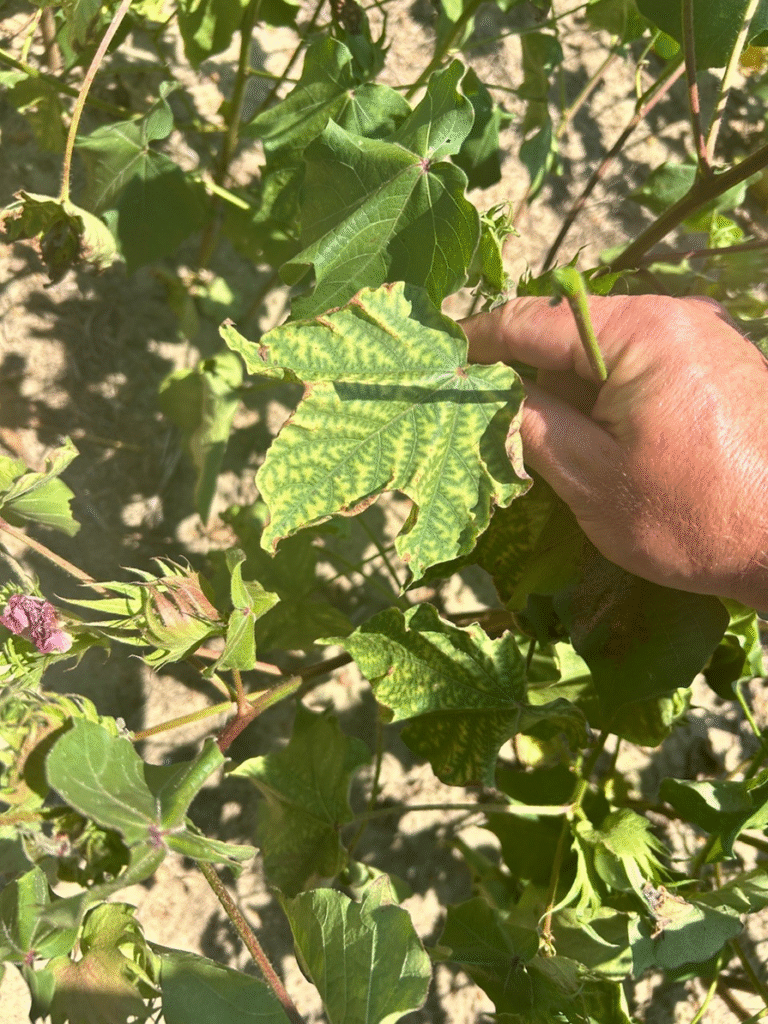
Zinc Toxicity of Peanut
From Josh in Lowndes Co. where he notes an area of severely stunted peanut plants clustered in an area of the field. The key word is “clustered”. If scattering might think Aspergillus crown rot. But in a pattern like this I think possibly nematodes (peanut root-knot or maybe sting) or Zinc toxicity (which can quickly be identified by splitting of the stems. Josh immediately remembered that pecan trees had been In that field until recently- almost a sure sign that zinc is to blame. Why? Because zinc fungicides are commonly used on pecans and this is a common problem when peanuts replace an old pecan grove. Here the pattern in the field and the field history were very helpful in arriving at a diagnosis for the grower.
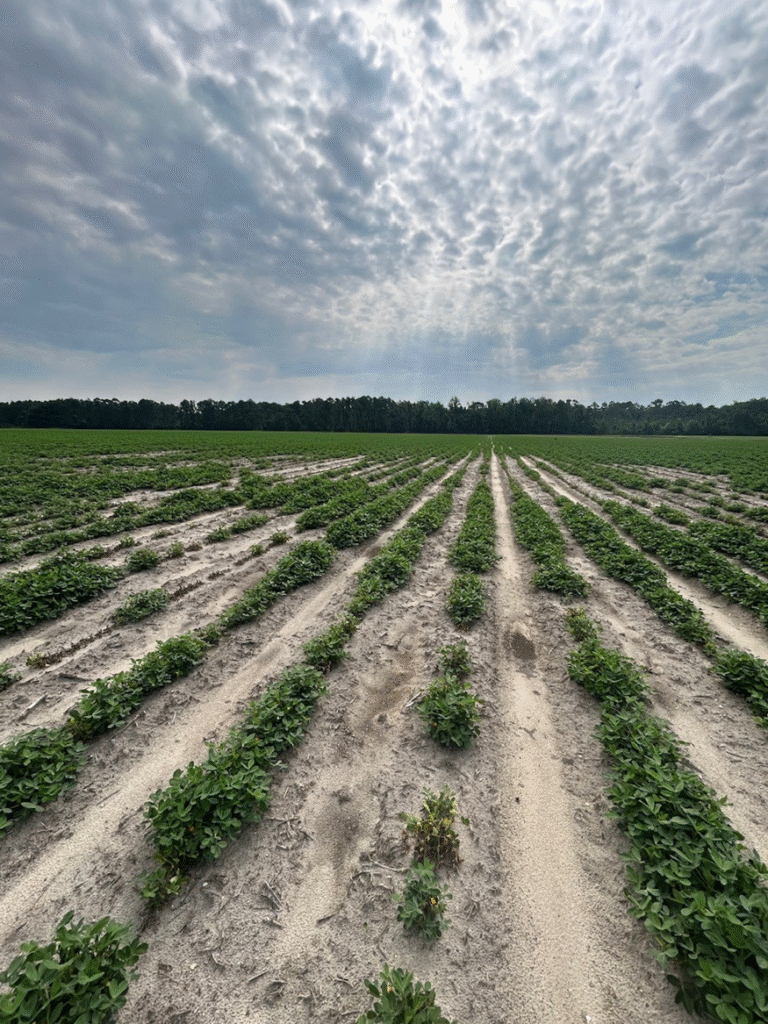
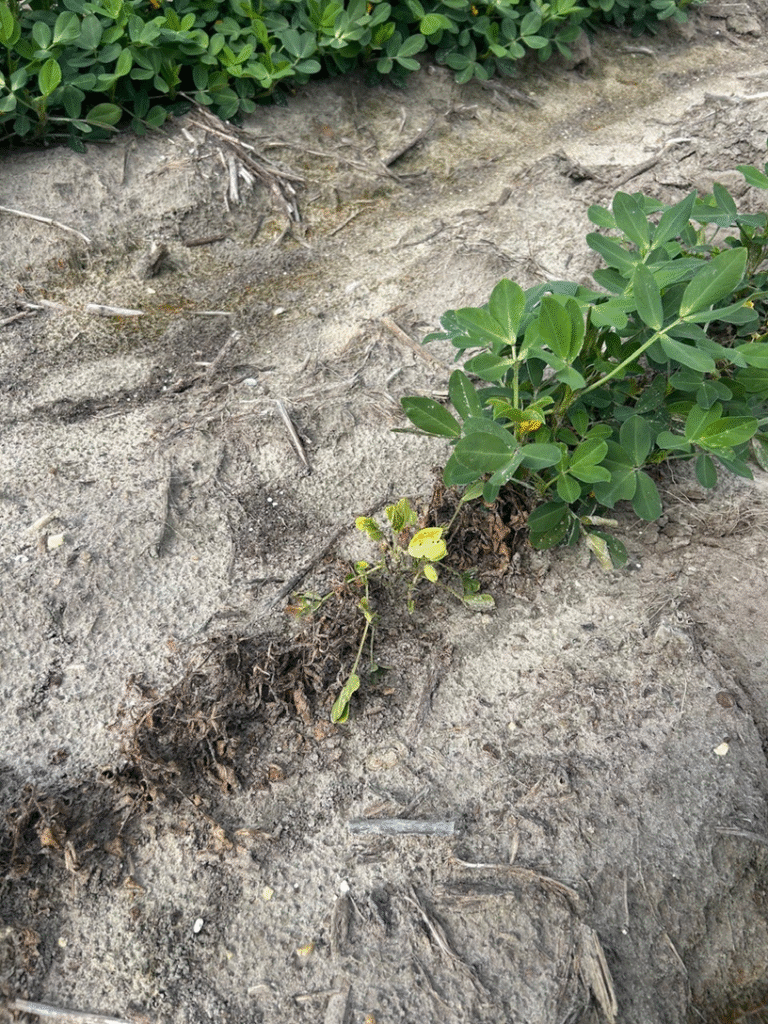
False White Mold of Peanut
Phanerochaete, that looks like the real thing, but causes no harm or injury to the plant. Note that as it ages it has a “toothed” and “yellow” appearance and is easily scraped from the healthy limbs. False white mold….
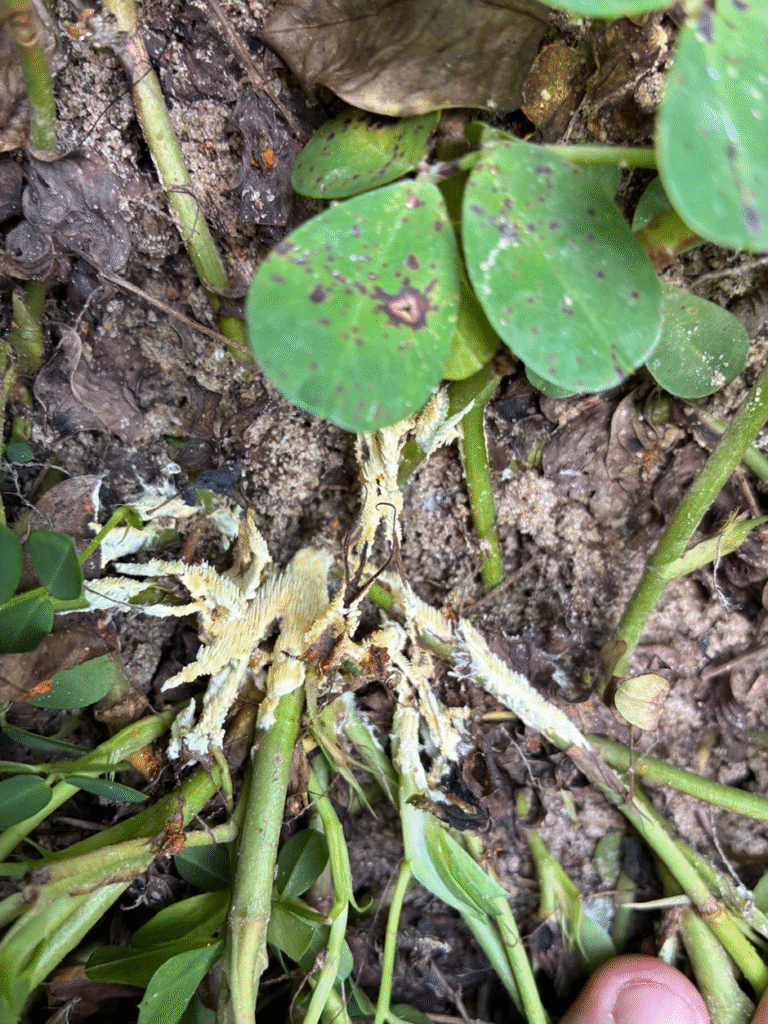
Tar Spot of Corn
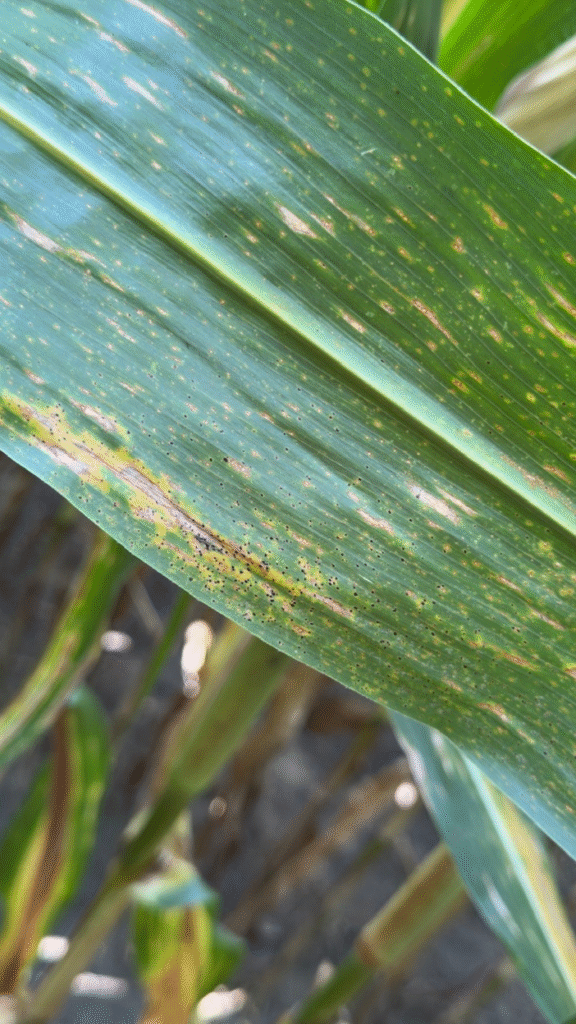
Florida Beggarweed in Peanut (Dr. Eric Prostko, UGA Weed Specialist)
I was texted the following picture (slightly blurry) early yesterday morning from a SW-GA crop consultant. He commented that it was all over the field.

This is Florida beggarweed (kidney-shaped cotyledons). When I first got to GA in 1999, Florida beggarweed was the #1 peanut weed. It became less troublesome when Valor (flumioxazin) was registered in 2001 (very effective) and when Palmer amaranth exploded. Florida beggarweed tends to be a later emerging weed and prospers during wetter conditions.
At this point in the growing season, there are not many good options for controlling Florida beggarweed in peanut. The first option is a POST (60 days after peanut emergence) application of Classic (chlorimuron). The other option is to use Gramoxone (paraquat) in a non-selective applicator (wiper, sponge, rope-wick). Both of these options are described on page 224 of the 2025 UGA Pest Control Handbook and/or listed below. Please carefully read the comment sections of these recommendations. Peanut cultivar tolerance to Classic is a major concern. If a newer peanut cultivar is not listed in the comment section (i.e. Arnie, TifNV-HG, etc.), that means I DO NOT have any tolerance data and have no clue what will happen.

July Peanut Insect Update (Dr. Mark Abney, UGA Peanut Entomologist)
It is the first of July, and the Georgia peanut crop is looking very good as a whole. Insect pressure has been pretty average to this point in the season. Lesser cornstalk borer (LCB) has been the most serious and widespread insect issue of 2025 so far. Growers need to continue scouting fields for LCB even in areas that have received ample rain. As irrigated fields (and non-irrigated fields where it is raining consistently) begin to lap the row middles, the risk for LCB reaching threshold levels is diminished. Later planting, skippy stands, sandy soil, and dry conditions are favorable for lesser cornstalk borer development; fields with these characteristics should be the focus of scouting efforts.
July is usually when we begin to see foliage feeding caterpillars in peanut in Georgia. 2025 is not the year for recreational caterpillar sprays. If a field is at threshold it should be treated, but spraying sub-threshold caterpillar populations just costs us money. Using a drop-cloth, check three feet of row at 10 random locations in each field. The threshold for foliage feeding caterpillars ranges from 4 per foot if the peanuts are small or stressed up to 8 caterpillars per foot when vines are healthy, rank, and actively growing. The threshold is “caterpillars per foot”…not per 3 feet, and it is an average of all 10 locations. All available data indicates that peanut can tolerate a lot of defoliation with no loss in yield. We have not seen the large numbers of beet armyworms in peanut this year that we saw in 2024. Nevertheless, we need to be vigilant in our scouting and make sure we properly identify any caterpillars we see. Choosing the wrong insecticide when caterpillars reach threshold can be a costly mistake.
Other insects that we will likely begin to see more of this month include three cornered alfalfa hopper, potato leaf hopper, and red-necked peanut worm. These insects do not generally warrant an insecticide application, but if you see lots of them in a field it is a good idea to talk with your local UGA county Extension agent.
Extension Precision Ag and Irrigation Blog Post (Dr. Wes Porter, UGA Precision Ag and Irrigation Specialist)
This is a shorter, but very important article. I could have written all day about this but wanted to keep it to the point. This week we covered thanks to help from my M.S. student Hannah Grubbs, the importance of weighting your soil moisture sensor data to match root growth and development. This is critical in utilizing sensors so that you don’t over or under irrigate.
Another one on irrigation, but this one is about irrigation termination on corn. This is a critical time period to be thinking about when to irrigate and when to terminate for the season. I want to give a big thank you to Ross Greene for already posting an article on this topic and helping with this one. Also, thanks to Nick Shay. If you have any further questions about corn irrigation termination feel free to reach out. Share this as it can help corn growers save yield and money.
July Cotton Team Newsletter and Talkin’ Cotton Podcast – UGA Cotton Team
https://www.buzzsprout.com/2350262/episodes/17448542
| Considerations for insect, foliar disease, and irrigation management in July 2025 – Talkin’ Cotton Podcast Drs. Phillip Roberts, Wes Porter, Bob Kemerait, and Camp Hand discuss the current status of the Georgia crop and some thoughts surrounding insect management, management of foliar diseases, and irrigation. www.buzzsprout.com |
All About The Pod Podcast – UGA Peanut Team

EPISODE 19, Season 3
In this episode, Scott Monfort, Mark Abney, Tim Brenneman, Albert Culbreath, Scott Tubbs, Wes Porter, and Amanda Smith discussed the current crop situation, pest management concerns, and a few comments on the current economic situation/farm bill. If you have any questions or would like to suggest topics for discussion on a future episode, contact your local UGA Extension agent.
EPISODE 20, Season 3
In this episode, Scott Monfort, Mark Abney, Wes Porter, Albert Culbreath, Scott Tubbs, Kaelyn Morgan, and Eric Prostko discussed the current crop situation, pest management concerns, and what to expect in the next few weeks. If you have any questions or would like to suggest topics for discussion on a future episode, contact your local UGA Extension agent.
Trump Administration Announces Expedited Congressionally Mandated Disaster Assistance for Farmers
Washington, D.C., July 9, 2025 – U.S. Secretary of Agriculture Brooke L. Rollins announced today that agricultural producers who suffered eligible crop losses due to natural disasters in 2023 and 2024 can now apply for $16 billion in assistance through the Supplemental Disaster Relief Program (SDRP). Read more using the link below…
https://content.govdelivery.com/accounts/USDAFARMERS/bulletins/3e8be16
Upcoming Meetings and Events
4-D Farm The Digital, Data-Driven Demonstration Farm
Dr. Wes Porter and Dr. Glen Rains are hosting an advanced Ag Technology field day at the ABAC Data Farm on August 21 from 8:30 AM – 12 PM. Agents and farmers are both welcome at the field day. Please see the attached flyer with the address, times, and a registration link. If you and/or a group of your county farmers plan to attend, please register by July 21 for meal planning purposes.
GA Cotton Commission Mid-Year Meeting
There is still time to register for the upcoming Mid-Year 2025 Georgia Cotton Commission meeting. This meeting will take place on Wednesday, July 23, 2025, at the Nesmith-Lane Conference Center on the campus of Georgia Southern University (GSU) in Statesboro. I have provided the agenda and link for pre-registration below. There is no cost to attend the event but pre-registration is requested for meal planning purposes.
| Home – The Georgia Cotton Commission – Perry, Georgia The Georgia Cotton Commission is a producer-funded organization located in Perry, Georgia. The Commission began in 1965. Georgia cotton producers pay an assessment enabling the Commission to invest in programs of research, promotion, and education on behalf of all cotton producers of Georgia. You can learn more about us by clicking the links below. georgiacottoncommission.org |